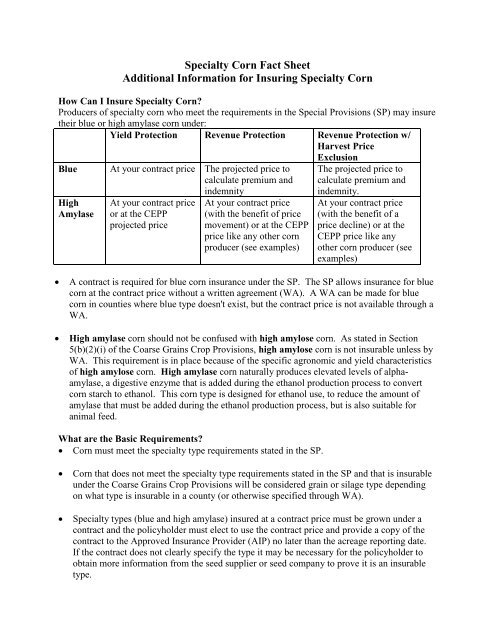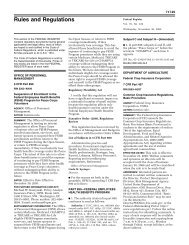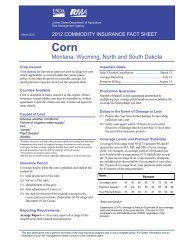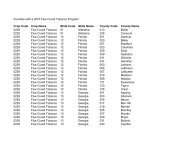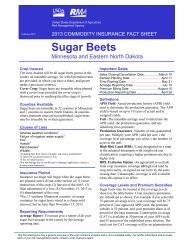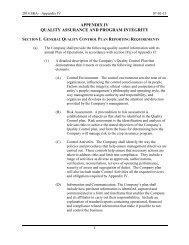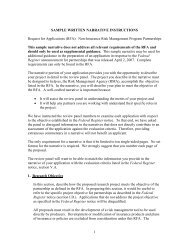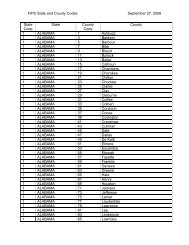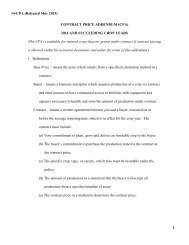RMA-Kansas City Office Letterhead
RMA-Kansas City Office Letterhead
RMA-Kansas City Office Letterhead
Create successful ePaper yourself
Turn your PDF publications into a flip-book with our unique Google optimized e-Paper software.
Specialty Corn Fact Sheet<br />
Additional Information for Insuring Specialty Corn<br />
How Can I Insure Specialty Corn?<br />
Producers of specialty corn who meet the requirements in the Special Provisions (SP) may insure<br />
their blue or high amylase corn under:<br />
Yield Protection Revenue Protection Revenue Protection w/<br />
Harvest Price<br />
Exclusion<br />
Blue<br />
High<br />
Amylase<br />
At your contract price The projected price to<br />
calculate premium and<br />
indemnity<br />
At your contract price<br />
or at the CEPP<br />
projected price<br />
At your contract price<br />
(with the benefit of price<br />
movement) or at the CEPP<br />
price like any other corn<br />
producer (see examples)<br />
The projected price to<br />
calculate premium and<br />
indemnity.<br />
At your contract price<br />
(with the benefit of a<br />
price decline) or at the<br />
CEPP price like any<br />
other corn producer (see<br />
examples)<br />
<br />
<br />
A contract is required for blue corn insurance under the SP. The SP allows insurance for blue<br />
corn at the contract price without a written agreement (WA). A WA can be made for blue<br />
corn in counties where blue type doesn't exist, but the contract price is not available through a<br />
WA.<br />
High amylase corn should not be confused with high amylose corn. As stated in Section<br />
5(b)(2)(i) of the Coarse Grains Crop Provisions, high amylose corn is not insurable unless by<br />
WA. This requirement is in place because of the specific agronomic and yield characteristics<br />
of high amylose corn. High amylase corn naturally produces elevated levels of alphaamylase,<br />
a digestive enzyme that is added during the ethanol production process to convert<br />
corn starch to ethanol. This corn type is designed for ethanol use, to reduce the amount of<br />
amylase that must be added during the ethanol production process, but is also suitable for<br />
animal feed.<br />
What are the Basic Requirements?<br />
Corn must meet the specialty type requirements stated in the SP.<br />
<br />
<br />
Corn that does not meet the specialty type requirements stated in the SP and that is insurable<br />
under the Coarse Grains Crop Provisions will be considered grain or silage type depending<br />
on what type is insurable in a county (or otherwise specified through WA).<br />
Specialty types (blue and high amylase) insured at a contract price must be grown under a<br />
contract and the policyholder must elect to use the contract price and provide a copy of the<br />
contract to the Approved Insurance Provider (AIP) no later than the acreage reporting date.<br />
If the contract does not clearly specify the type it may be necessary for the policyholder to<br />
obtain more information from the seed supplier or seed company to prove it is an insurable<br />
type.
The contract (acreage based, acreage and production based, or production based) must be<br />
executed by the policyholder and the business enterprise and be in effect for the applicable<br />
crop year.<br />
If there is more than one contract price for the same type, a weighted average price for the<br />
type will be used.<br />
How Does Contract Pricing Work For Yield Protection?<br />
The projected price for a fixed price contract will be the contract price. If the contract<br />
provides a premium over a price, the projected price will be that premium amount added to<br />
the CEPP projected price. The contract price cannot exceed the amount determined by<br />
multiplying the CEPP projected price by the contract price limit factor shown in the SP.<br />
How Does Contract Pricing Work For Revenue Protection?<br />
The projected price for a fixed price contract will be the contract price. The harvest price<br />
will be the CEPP projected price subtracted from the contract price and the difference added<br />
to the CEPP harvest price. The contract price cannot exceed the amount determined by<br />
multiplying the projected price by the contract price limit factor shown in the SP. For<br />
example,<br />
$7.15 Contract price<br />
$6.00 CEPP projected price<br />
$7.15 Projected price<br />
used to determine guarantee<br />
$7.15 Projected price<br />
-$6.00 CEPP projected price<br />
$1.15 Difference between contract &<br />
projected price<br />
Limit factor=1.20<br />
Not limited because:<br />
$6.00 x 1.20= $7.20<br />
$7.00 CEPP harvest price<br />
+$1.15 Difference<br />
$8.15 Harvest price used to determine<br />
indemnity<br />
<br />
If the contract provides a premium over market price, the specialty corn projected price will<br />
be the premium amount added to the CEPP projected price. The harvest price the price will<br />
be the CEPP projected price subtracted from the specialty corn projected price and the<br />
difference shall be added to the CEPP harvest price. The contract price cannot exceed the<br />
amount determined by multiplying the projected price by the contract price limit factor<br />
shown in the SP. For example,<br />
$6.00 CEPP projected price<br />
+$1.25 Contract premium price<br />
$7.25 Projected price used to determine<br />
guarantee (subject to limit factor)<br />
$7.20 Projected price<br />
- $6.00 CEPP projected price<br />
$1.20 Difference between contract &<br />
projected price<br />
Limit factor=1.20<br />
Limited because:<br />
$6.00 x 1.20= $7.20<br />
$7.00 CEPP harvest price<br />
+$1.20 Difference<br />
$8.20 Harvest price used to determine<br />
indemnity
What Are The Underwriting Rules?<br />
Crop Insurance Handbook Information<br />
Refer to FCIC-18010 Crop Insurance Handbook (CIH), Section 13C(3), for instructions on<br />
establishing or dividing APH databases when actuarial documents release new<br />
practices/types (P/T), divide an existing P/T into new P/T(s), or modify an existing P/T<br />
specifications that may impact what P/T the crop production history is considered.<br />
o Separate APH databases are required for each P/T listed on the actuarial documents<br />
that has been produced in previous crop years or the policyholder plans to plant for<br />
the current crop year. This applies even when transitional yields (T-Yields) are the<br />
same for different types and regardless of whether the policyholder chooses to<br />
insure based on a contract price.<br />
o If the production history contained within the APH database does not change as a<br />
result of the new P/T code change, or the policyholder already has APH databases<br />
established according to the new P/T(s), no action is necessary except to apply the<br />
proper P/T code to the database (the 10 percent yield limitation applies).<br />
o Policyholders may certify production and acreage when establishing or dividing<br />
APH databases, but must maintain and provide supporting acceptable records in<br />
accordance with applicable procedures.<br />
o If T-Yields among types are the same the order of precedence to determine the<br />
higher yielding type is: grain, high amylase, and blue.<br />
<br />
Due to the specialty corn insurance program being released after the 2013 CIH was issued,<br />
the CIH will be updated upon the next issuance.<br />
Loss Adjustment Information<br />
Specialty corn will be quality adjusted as corn for grain, except blue corn will not receive<br />
quality adjustment. The discount factor (DF) charts in the SP, or the reduction in value<br />
(RIV) for corn as grain and local market price (LMP) for U.S. No. 2 yellow corn, as<br />
applicable, will be used for quality adjustment purposes, without regard to any contract price<br />
for the specialty type insured.<br />
<br />
Example: A policyholder has a contract for 100 acres of high amylase corn. The contract<br />
price for high amylase corn is $7.20 per bushel. The acreage produces 40 bu. per acre (4,000<br />
bu.) All contracted production is delivered to the processor. Due to insurable causes, the<br />
production has a test weight of 40 lbs. per bushel. As a result, the processor discounts the<br />
high amylase corn $2.00 a bushel. The policyholder receives $5.20 per bushel for the<br />
production.<br />
On the day the corn was sold to the processor, the LMP for U.S. No. 2 yellow corn is $7.00<br />
per bushel. The RIV for corn as grain with the same 40 lb. test weight is $4.00. Regardless<br />
of the discount applied by the processor for the high amylase corn, quality adjustment will be
ased on the RIV for corn as grain and the LMP for U.S. No. 2 yellow corn at the time of<br />
sale. In accordance with the SP, the Quality Adjustment Factor (QAF) and production to<br />
count will be determined as follows:<br />
o $4.00 corn as grain RIV / $7.00 U.S. No. 2 yellow corn LMP = .571 DF<br />
o .571 DF = .429 QAF<br />
o 100 acres X 40 bu.= 4,000 bu. of high amylase corn X .429 QAF= 1,716 bu. production<br />
to count.<br />
<br />
Refer to the Crop Insurance Handbook, Loss Adjustment Manual, Corn Loss Adjustment<br />
Standards Handbook, and Prevented Planting Loss Adjustment Standards Handbook for<br />
more procedures regarding crops with multiple types.


